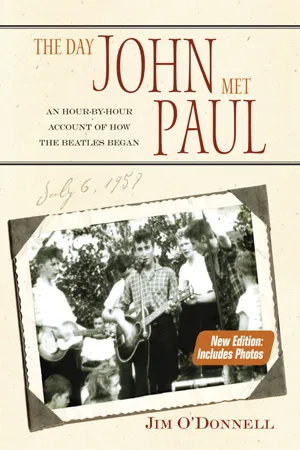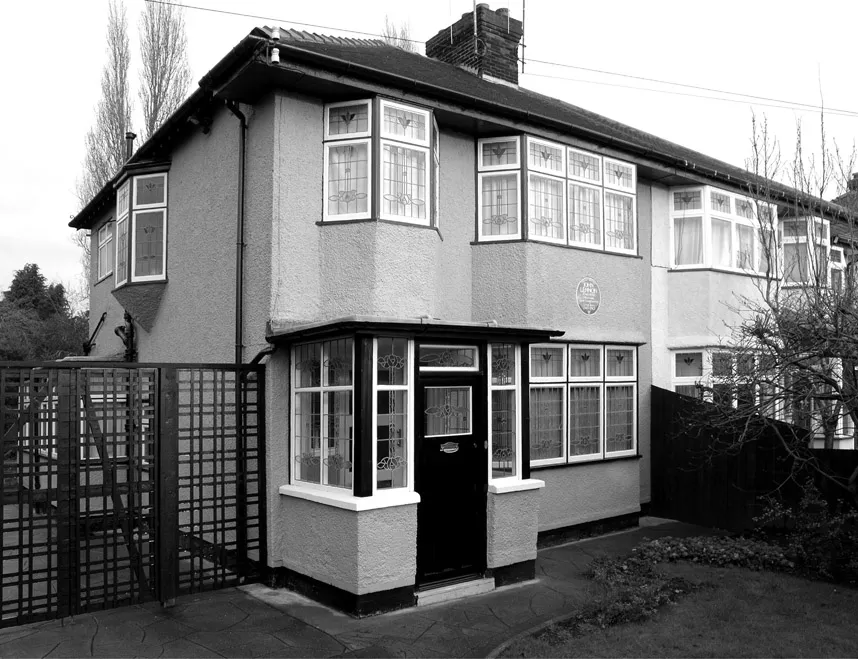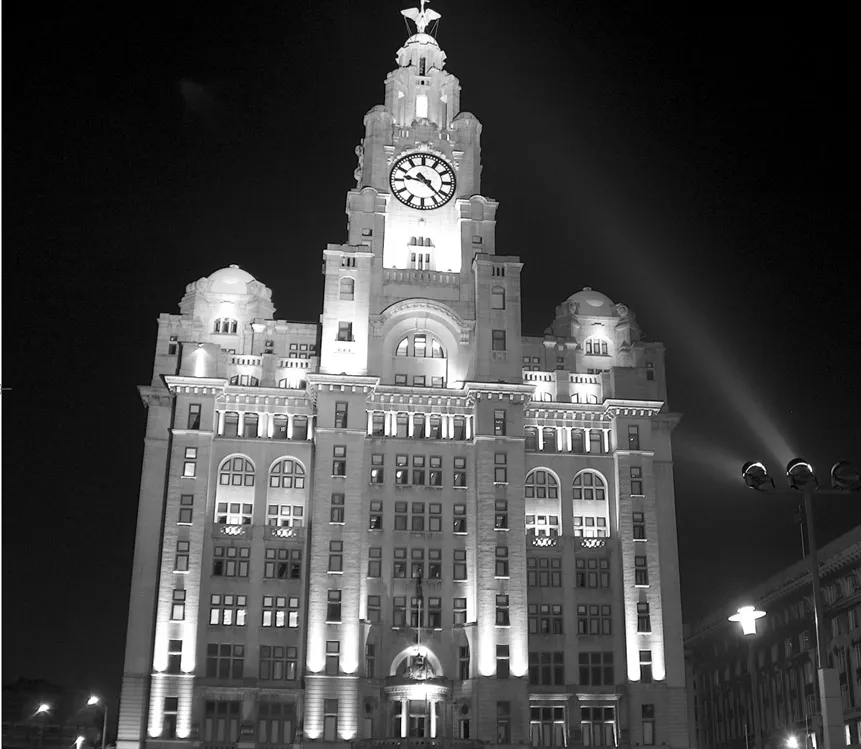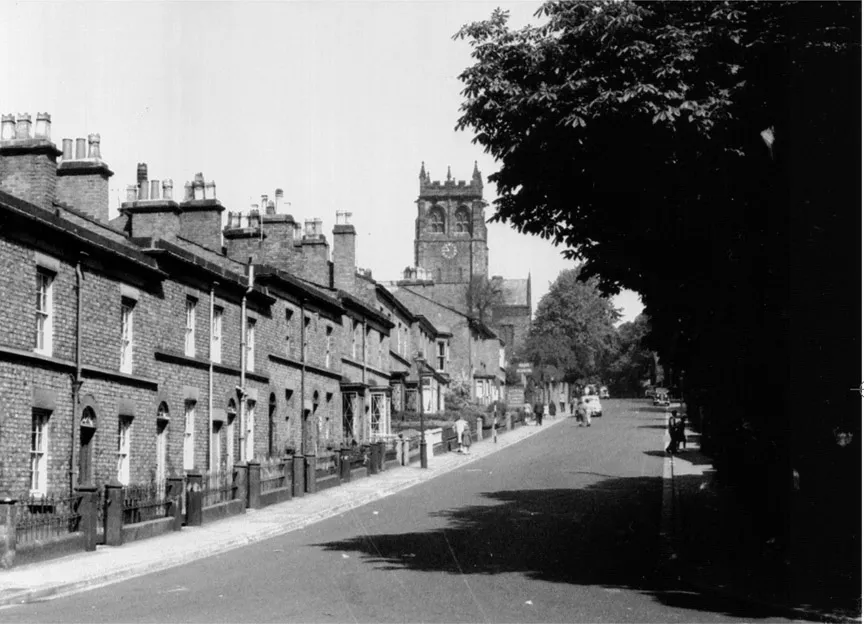![]()
PART I
THE MORNING HOURS
LIVERPOOL WATERFRONT
The public image of Liverpool in 1957 is a city of ships and wits; footballers and street brawlers; nasal accents and nasty accidents; liners of might and ladies of the night.
(Daily Herald/Science & Society Picture Library)
![]()
Early A.M.
THE TOUSLE-HAIRED teenager in the small bedroom sleeps the deep sleep of the young. His breathing is soft and slow and steady. He removes a hand from under the sheets and unconsciously rubs the upper bridge of his angular nose at the spot where his glasses rest when he’s reading. The glasses are on his little dresser. The thick lenses in their thick black rims eyeball him from across the bedroom above the front porch of 251 Menlove Avenue, Liverpool, England. In his golden slumbers, the tall teen can’t know that the day ahead will be the kind around which bedtime stories are woven—a day that will spawn history, a day of magic.
The time is 3:33 A.M. The date is Saturday, July 6, 1957. The season is summer, the time of year when magic and music and memory become one. It is a soft-scented morning as Liverpool reposes in black velvet. The temperature is 60 degrees, the humidity is 94 percent, and the feeling in the opaque darkness is sultry. It is, in fact, the beginning of the tenth day of a heat wave that has fire stormed its way across Western Europe. The weather has gone crazy. The sun has been brazen. Day by day it has beaten down on Western Europe like a flaming blowtorch. Yesterday, July 5, it was 98 degrees in Italy, 99 in Vienna, 125 in Prague—not kind to old cities or to old bones. It has been not just a heat wave but an atmospheric conflagration.
Now, in this early July A.M., the day comes up molten hot again, and Western Europe will be sunbaked. The predawn humidity pours through the tenebrous lanes and fields and piers of Liverpool. It is bizarre weather for this city where an 80-degree day is considered a scorcher, even in summertime. The sky wears a gun-metal flatcap. It gives Liverpool a ghostly cast. In a Liverpool suburb, a lone blackbird cocks its head and goes for a high note. The bird hits it. It finds the color of night to be in good taste. A small covey of sparrows begins to chatter. A fluttering robin, more business-school than communications-school oriented, takes the express lane between two sycamore trees and looks for worms in a flower bed.
At 3:45 A.M. the teenager in the seven-by-eleven-foot room on Menlove Avenue has moved not a whit. He lives on a wide boulevard of a street. The road is a “dual carriageway”—two lanes in each direction. A tall hedge runs down the middle, over obsolete trolley tracks. An occasional car or taxi or truck passes by and sails a little ferry of yellow across the teen’s bedroom ceiling. On the ceiling is a large poster of the blonde French actress Brigitte Bardot. The passing headlights make her hair seem candlelit. There is another poster in the room. It’s of Elvis Presley. In this deepest dark of night, neither the boy nor his power-prescription specs would be able to easily see the poster, even though the landing light is on in the hall.
THE ONLY BRIGHT illumination in Liverpool at this hour is the Pier Head clock a few miles away. The giant old clock gives the River Mersey an iridescent splendor. Each A.M., as the fine sands of the new day begin their run to the bottom of the glass, the clock gives
JOHN LENNON’S HOME, 251 MENLOVE AVENUE, WOOLTON, LIVERPOOL
At 3:45 A.M. the teenager in the seven-by-eleven foot room on Menlove Avenue has moved not a whit. Lennon’s peach crate of a bedroom is one of seven rooms in the semidetached brick villa.
(Dave Wood/Liverpool Pictorial)
the waterfront a fresh coat of yellow. Its glow caroms off the river in little glints, making beauty out of the implacable enemy, time. The clock commands a noble view of the river. It looks out from under one of the two green eighteen-foot Liver Bird statues that perch atop the Royal Liver Building.
The clock’s hands point to 3:56 A.M. The sky is a dark silver. A sea breeze combs the dockside. There is a mist over the Mersey. The river makes a coruscating portrait of Liverpool’s dock lights. A total of seven and a half miles of docks form the hub of the city’s shipping business. Wharves and warehouses and workers keep up the charade that life is fair. The workers’ faces are sullen. Memories of better days keep their souls intact. A sailor stares at a giant, unused crane and sings the spirit of his far-off home port into the clammy Liverpool night.
A few clouds scud behind the Pier Head clock on the Royal Liver Building. There is a warm feeling to the structure. Even in grimy gray, it holds a solemn sedateness. Amongst the seagulls, against the sea wind, there is the mournful piping of a ship’s horn. It is a sound and scene that the slumbering teenager knows well. He often goes to the waterfront and stares longingly after ships as they shove off on their seafaring journeys.
IT’S 4 A.M. The sky has lightened, but Liverpool is still a dark chalk ledge under a bluish blackboard. More birds send out wake-up calls. The air is thick and still. On Menlove Avenue the teenager, John Winston Lennon, snoozes in the wee hours. He lives there with his aunt, three cats, and a dog named Sally. On this day, he is sixteen years, eight months, three weeks, and six days old, three months away from his seventeeth birthday. His fingers are callused and he has long sideburns. In a matter of days he finishes school. Today being Saturday, the classrooms are locked. Not much could please the young Lennon more.
The screenless leaded windows of his room are opened out and up. His shirt hangs on a doorknob; his pants are on his dresser next to his glasses; his socks are on the extension speaker hooked up to the parlor radio-phonograph downstairs. His peach crate of a bedroom is one of seven rooms in the semidetached brick villa. The rooms are pleasant and cozy. The home’s nickname is “Mendips,” after the lush green English hills. They name houses to give them a touch of individuality. Owned by the Smith family, the two-story home features bay windows and flower beds and hedges in a manicured front garden. At this hour, the buds of May flash bright July petals. A geranium blossom yawns in the sable silence. Some breeze-stirred blades of grass reach over to attempt a polite stifle.
The middle-class home sits snugly on a borderline: It is technically in the ward of Allerton, but carries the postmark of the village of Woolton. In essence, the house is in Allerton by map, but in Woolton by shopping, public transportation, milkman, postal address, and parish. One might say 251 Menlove Avenue sleeps in Allerton, but lives in Woolton. Or, more to the point, that the home’s brain is in Allerton, but its mind is in Woolton.
The village is Woolton; the house is Mendips; the county is Lancashire; the country is England. But no geographical factor has shaped the character of the sideburned teenager as much as the city—which is Liverpool. By 4:14 A.M. the Liverpool sky is a pale blue canopy. Smokestacks feed dark blue plumes into the shark teeth of the industrial skyline. There’s some light in the sky. The slow brightening is serene.
THE SERENITY OVERHEAD clashes with the earthly mood of Liverpool. The city has been charged of late—charged with the current of current events, and charged with change. The place is still abuzz over the visit of Queen Elizabeth on Tuesday, June 25. The queen graced the city to share in the 750th anniversary of
PIER HEAD CLOCK FACING RIVER MERSEY
The giant old clock gives the River Mersey an iridescent splendor.
(Dave Wood/Liverpool Pictorial)
Liverpool’s charter. The theme of the yearlong charter celebrations is “Liverpool Leads.” From house-decorating competitions to fancy flower displays, residents are taking the anniversary to heart and making a memorable time of it. In terms of change, Liverpool is in the midst of major surgery on what amounts to a city’s backbone: its transportation. The year 1957 marks the beginning of two fundamental changes in how people get around the skeleton of Liverpool’s streets. In December of the previous year, the city closed down the pounding steel-wheeled, sixteen-foot-high Liverpool Overhead Railway. And trams are being phased out in favor of buses and motorcars. In two months, the Baby Grand 293 will drive the last route for Liverpool trams. The pungent scent of black leather tram seats will waft into an era bygone.
For many, the loss of the overhead train and the tram car is a beheading of their city’s past. In their memory, the head of the city is the mode of its transportation. Now the head is being lopped off. The older the Liverpool denizen, the greater the sense that the city is losing its identity as it loses its overhead and tram lines.
AT 4:20 A.M., there are few trying to figure out the geometry of Liverpool’s blue-shadowed streets. Yet already, this early, there is a liveliness to Liverpool. The city is far from the wealthiest in the world, but it daily produces a million dollars-worth of personality. At heart, Liverpool is a city lit with wit. The city sits on an undeviating sandstone slope. The word Liverpool derives from a Norse word meaning “pool of the slopes.” Liverpool wit runs through the storybook city every day like a stream of gold.
The public image of Liverpool is a city of ships and wits; footballers and street brawlers; nasal accents and nasty accidents; liners of might and ladies of the night. An invaluable landmass of English life, this uptempo city is 202 miles northwest of London. It holds down the right bank of the River Mersey and is the second largest port in the British Isles. In 1957, there is a polyglot population of 768,700: English, Irish, African, Chinese. Industrial plants and kingsize parks make it a city of both ash and grass; of grotesque grinding and garrulous gardens.
The grass—and everything else in Liverpool—nearly turned to ash in the early 1940s. During World War II, Hitler pounded the Liverpool landscape. Besides warehouses and plants, personal dwellings took a beating. Almost 7,000 homes were demolished and another 125,000 were left partly standing. By 1957, things are starting to settle down for the city. The people are resilient and tough. The living standard is shifting into a postwar upswing. Life is getting back to normal, if slowly.
Unfortunately, the city buildings cannot renew themselves as fast as the people can. Official relandscaping programs began five years ago, in 1952. But the task is titanic and the pace is snail-like. So by 1957, the bleeding of postwar Liverpool has stopped, but the scars are still fresh. The experience of the war still seems to exact a daily pound of flesh. The terrain is jagged with blast marks and pits and cavities of earth. There are weed patches on the bombsites. The center of the city has the texture of an old shoe that has been cobbled one too many times. The war has bled Liverpool to the point where its face has turned black as wet coal. At 4:31 A.M., black-sooted and crater-ridden, it looks like England’s dark side of the moon. A filmy gray sky blankets the burnt-out shell of a car on the Dock Road.
THREE MILES SOUTH of Liverpool’s City Centre dock area, the teenager on Menlove Avenue, in better-heeled Woolton, sleeps like a cat. From the waterfront to Woolton is a classic city-to-suburb sojourn. Of Liverpool’s 27,818 acres, the suburban village of Woolton occupies 2,181, most of it winding roads and tall trees. The village is an emerald in the rusty ring of industrial Liverpool. The air is cleaner and the streets are quieter and the time moves
CHURCH ROAD, WOOLTON, LIVERPOOL, THE FIFTIES, ST. PETER’S CHURCH IN BACKGROUND
Woolton Village is an emerald in the rusty ring of industrial Liverpool. The air is cleaner and the streets are quieter and the time moves more slowly. The year may be 1957, but there are no supermarkets here.
(James L. Davis)
TOP HAT RECORDS BAR, 1957, DALE STREET, LIVERPOOL
Crowds of teenagers wait for the arrival of Mitchell Torok, a Canadian singer who has a Top Ten hit in the U.K. called “Mexico Gave Up the Rumba to do the Rock and Roll.”
(Reflections Photo Archive)
more slowly. This lovely jewel of a village is a patchwork of parks and churches and shops and homes that never lock their doors. Woolton is genteel—a big garden of a suburb that works hard to keep a village veneer. The year may be 1957, but there are no supermarkets here. The place is that untinctured by modernity. The people lead lives that are fruitful, family-centered, and fixed to the wonders of nature. Fame is not a value here. The village has thrived in this peaceful way.
The woodsy streets are mostly unpeopled at this hour. You could stand on any corner, look up and down the lane, and wonder if this sleepy little town has taken to the horseless carriage yet. Sleep for some, however, is not as engulfing as usual. The reason is that this is the biggest day of the year in Woolton: the St. Peter’s Parish Church Garden Fete, an annual fair held in early summer for the benefit of the church.
For the less-than-cosmopolitan village, it is a party, fair, parade, feast, carnival, social, dance, circus, concert, and picnic all rolled into one. The event, in one way or the other, touches every doorstep in the parish. The community focalizes on this day. Virtually everyone takes part—kids, teens, adults, elderly. Many people, actually, already slowed themselves down on Thursday and Friday, husbanding their energy for the Big Day.
THE TEENAGER ON Menlove Avenue does not sleep fretfully, even though the Big Day is bigger for him than for most. He plays guitar and has a band that will be playing at the church fete. It’s the first time that a teenage pop band has ever been asked to play for the occasion, although the group not only isn’t the main event of the day, it isn’t even the main musical event. The main event, the big attraction, is a dog show. As for music, the teen band has been invited as a novelty act for a bit of fun. The idea is that flavoring the show with a youngish rock and rollish sound will provide a loose flip side to the day’s standard fare, as well as please the kids.
A MARVEL OF movement, rock and roll in the fifties has hit England as hard as any wartime firepower. It pervades the quotidian life of the country like an odorless gas. The American rock guitar has crossed swords with the British royal scepter, and even the windows of Woolton are rattling. Rock isn’t only lasting: it daily dispatches three-chorded warships of rock and roll platoons over the radio.
The talismanic power of the three chords is not lost on the Woolton teenager named Lennon. He is immersed in the music. His thoughts pullulate with the beat of it. He has a guitar and it is the bright trophy of his life. The guitar has no case. It doesn’t need one. He doesn’t put it away. From the day Lennon got it, the guitar has spent more time airborne than Lindbergh.
IT’S 4:42 A.M. and a scant easterly breeze brushes the budding musician in his bed on Menlove Avenue. Down the street, around the corner of Beaconsfield Road, another breeze curls through the rococo iron grating of the gates at Strawberry Field, seven foot four inches at their highest point. The gates guard a Salvation Army orphanage that presently accommodates twenty children. They also enclose several acres of thick foliage. The summer trees wear a conceited green. Some of teenage Lennon’s best hours are spent on these grounds. He loves to laugh and play and dream here.
BY A QUARTER to five in the morning, Woolton’s myriad birds are in full song. They chatter away, fly to new eaves, and issue more tunes from the tall trees. Some of the trees are so tall, they seem to flirt with the whitening sky.
Dawn awaits behind Woolton’s trees and church spires.
![]()
Dawn
THE ASHEN SKY bides its time in anticipation of the first glimmer of...







